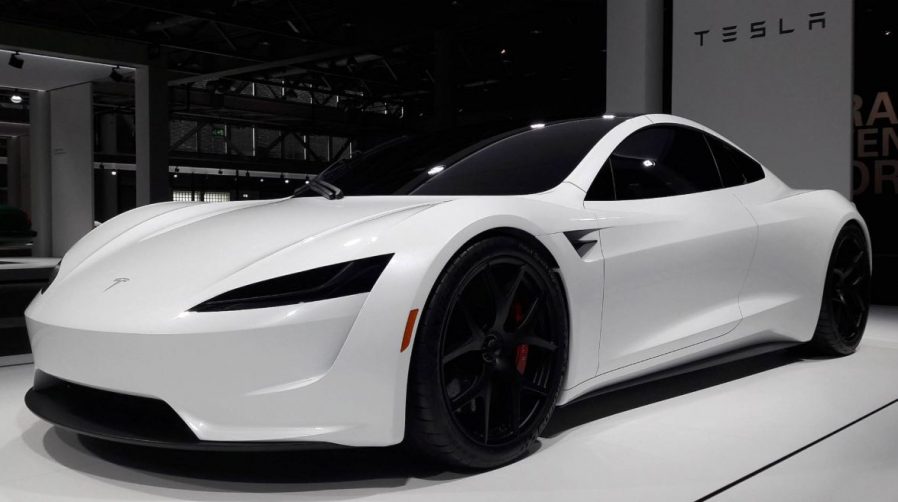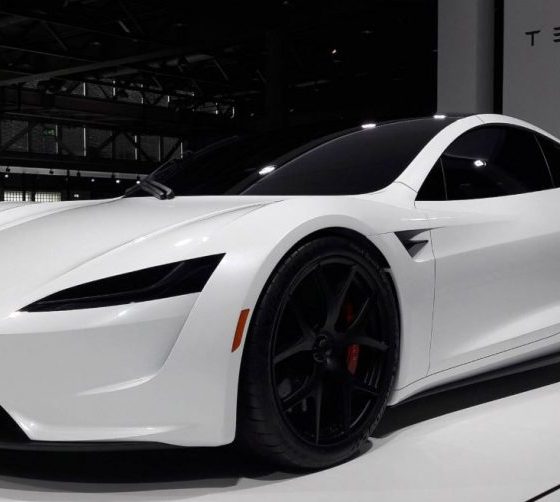

News
Elon Musk details Tesla Roadster hovering capability with Joe Rogan
Tesla CEO Elon Musk joined Joe Rogan on the Joe Rogan Experience Podcast for the third time, with the episode releasing earlier today. In the episode, Musk detailed some more specifics regarding the production of the next-gen Roadster, shedding more light on Tesla’s incomplete but highly-anticipated project. Musk dove into the possibility of the Roadster’s ability to hover with Rogan, indicating it could be limited to reduce the risk of injury.
Musk’s third appearance with Joe Rogan
Musk joined Joe Rogan once again for his third appearance on the JRE Podcast. Rogan tweeted the podcast episode’s release on February 11th, available exclusively on Spotify, which Rogan signed a massive contract with in 2020.
Musk has joined Rogan on the Joe Rogan Experience Podcast on two previous occasions: once on September 7th, 2018, and another on May 7th, 2020. The first appearance in 2018 is Rogan’s most viewed podcast episode on YouTube with over 40.7 million views. The second appearance from Musk yielded slightly fewer views at 20.5 million but still stands at the fourth-most popular episode in the history of the JRE Podcast.
Musk and Rogan skimmed over various important topics in the latest episode. One of the most notable was Musk’s comments regarding the next-generation Tesla Roadster, which has been in development for several years.
View this post on Instagram
Next-Gen Tesla Roadster Hovering Ability
Musk told Rogan that Tesla is “finishing the engineering of the Roadster this year” and will “hopefully” begin shipping the car sometime next year. “We’re going to throw some rocket technology in that car,” Musk stated, speaking of the speculative SpaceX package that is expected to be released. Musk and Tesla plan to put cold-gas SpaceX thrusters on the car, giving it improved acceleration (as if it needed any). The CEO also stated that he would like to put thrusters underneath the car for hovering capabilities, but it hasn’t been figured out yet.
Musk said:
“I want it to hover. I’m trying to figure out how to make this thing hover, without, you know, killing people. I thought, maybe we could make it hover, but not too high. So maybe it could hover, like, a meter above the ground, or something. So, if you plummet, you blow out the suspension, but you’re not going to die. Maybe, I don’t know, six feet. If we put a height limit on it, it will probably be fine.”
ALSO READ:
Tesla Roadster will be “part rocket” to beat Model S Plaid+ specs
Rogan then asked if the Roadster will be able to travel while it is suspended in mid-air. Musk simply replied, “Yeah.”
Musk told Rogan that the rate of travel while hovering will be “pretty fast,” but that it would be subjected to time limits to restrict operators from being off of the ground for too long. However, it comes with some catches.
If a Roadster owner wants the SpaceX package, it will remove the back two passenger seats, meaning only two people will be able to sit in the car at one time. Instead, the rear seats will be replaced by a high-pressure carbon overwrap pressure vessel, which would be “around 10,000 PSI,” Musk says. A series of thrusters will join the vessel.
Musk acknowledges that this may not be possible, though. He talked about what could be released instead.
“At a minimum, I’m confident we could do a thruster where the license plate flips down, James Bond-style, and there would be a rocket thruster behind it, and that gives you three tons of thrust.”
Roadster Production and Release
Musk plans to have engineering finished on the Roadster this year, a detail he released after the 2020 Q4 Earnings Call in late January.
Finishing engineering this year, production starts next year. Aiming to have release candidate design drivable late summer. Tri-motor drive system & advanced battery work were important precursors.
— Elon Musk (@elonmusk) January 28, 2021
Additionally, Roadster release candidates could be on the road this Summer. “Tri-motor drive system & advanced battery work were important precursors,” Musk also said. Now, the work could turn to whether Tesla engineers can figure out how to make the next-gen Roadster hover and travel at the same time, a far cry from the vehicle Tesla released initially in 2008.
Musk’s full interview with Rogan is available here.

Elon Musk
Starlink passes 9 million active customers just weeks after hitting 8 million
The milestone highlights the accelerating growth of Starlink, which has now been adding over 20,000 new users per day.

SpaceX’s Starlink satellite internet service has continued its rapid global expansion, surpassing 9 million active customers just weeks after crossing the 8 million mark.
The milestone highlights the accelerating growth of Starlink, which has now been adding over 20,000 new users per day.
9 million customers
In a post on X, SpaceX stated that Starlink now serves over 9 million active users across 155 countries, territories, and markets. The company reached 8 million customers in early November, meaning it added roughly 1 million subscribers in under seven weeks, or about 21,275 new users on average per day.
“Starlink is connecting more than 9M active customers with high-speed internet across 155 countries, territories, and many other markets,” Starlink wrote in a post on its official X account. SpaceX President Gwynne Shotwell also celebrated the milestone on X. “A huge thank you to all of our customers and congrats to the Starlink team for such an incredible product,” she wrote.
That growth rate reflects both rising demand for broadband in underserved regions and Starlink’s expanding satellite constellation, which now includes more than 9,000 low-Earth-orbit satellites designed to deliver high-speed, low-latency internet worldwide.
Starlink’s momentum
Starlink’s momentum has been building up. SpaceX reported 4.6 million Starlink customers in December 2024, followed by 7 million by August 2025, and 8 million customers in November. Independent data also suggests Starlink usage is rising sharply, with Cloudflare reporting that global web traffic from Starlink users more than doubled in 2025, as noted in an Insider report.
Starlink’s momentum is increasingly tied to SpaceX’s broader financial outlook. Elon Musk has said the satellite network is “by far” the company’s largest revenue driver, and reports suggest SpaceX may be positioning itself for an initial public offering as soon as next year, with valuations estimated as high as $1.5 trillion. Musk has also suggested in the past that Starlink could have its own IPO in the future.
News
NVIDIA Director of Robotics: Tesla FSD v14 is the first AI to pass the “Physical Turing Test”
After testing FSD v14, Fan stated that his experience with FSD felt magical at first, but it soon started to feel like a routine.

NVIDIA Director of Robotics Jim Fan has praised Tesla’s Full Self-Driving (Supervised) v14 as the first AI to pass what he described as a “Physical Turing Test.”
After testing FSD v14, Fan stated that his experience with FSD felt magical at first, but it soon started to feel like a routine. And just like smartphones today, removing it now would “actively hurt.”
Jim Fan’s hands-on FSD v14 impressions
Fan, a leading researcher in embodied AI who is currently solving Physical AI at NVIDIA and spearheading the company’s Project GR00T initiative, noted that he actually was late to the Tesla game. He was, however, one of the first to try out FSD v14.
“I was very late to own a Tesla but among the earliest to try out FSD v14. It’s perhaps the first time I experience an AI that passes the Physical Turing Test: after a long day at work, you press a button, lay back, and couldn’t tell if a neural net or a human drove you home,” Fan wrote in a post on X.
Fan added: “Despite knowing exactly how robot learning works, I still find it magical watching the steering wheel turn by itself. First it feels surreal, next it becomes routine. Then, like the smartphone, taking it away actively hurts. This is how humanity gets rewired and glued to god-like technologies.”
The Physical Turing Test
The original Turing Test was conceived by Alan Turing in 1950, and it was aimed at determining if a machine could exhibit behavior that is equivalent to or indistinguishable from a human. By focusing on text-based conversations, the original Turing Test set a high bar for natural language processing and machine learning.
This test has been passed by today’s large language models. However, the capability to converse in a humanlike manner is a completely different challenge from performing real-world problem-solving or physical interactions. Thus, Fan introduced the Physical Turing Test, which challenges AI systems to demonstrate intelligence through physical actions.
Based on Fan’s comments, Tesla has demonstrated these intelligent physical actions with FSD v14. Elon Musk agreed with the NVIDIA executive, stating in a post on X that with FSD v14, “you can sense the sentience maturing.” Musk also praised Tesla AI, calling it the best “real-world AI” today.
News
Tesla AI team burns the Christmas midnight oil by releasing FSD v14.2.2.1
The update was released just a day after FSD v14.2.2 started rolling out to customers.

Tesla is burning the midnight oil this Christmas, with the Tesla AI team quietly rolling out Full Self-Driving (Supervised) v14.2.2.1 just a day after FSD v14.2.2 started rolling out to customers.
Tesla owner shares insights on FSD v14.2.2.1
Longtime Tesla owner and FSD tester @BLKMDL3 shared some insights following several drives with FSD v14.2.2.1 in rainy Los Angeles conditions with standing water and faded lane lines. He reported zero steering hesitation or stutter, confident lane changes, and maneuvers executed with precision that evoked the performance of Tesla’s driverless Robotaxis in Austin.
Parking performance impressed, with most spots nailed perfectly, including tight, sharp turns, in single attempts without shaky steering. One minor offset happened only due to another vehicle that was parked over the line, which FSD accommodated by a few extra inches. In rain that typically erases road markings, FSD visualized lanes and turn lines better than humans, positioning itself flawlessly when entering new streets as well.
“Took it up a dark, wet, and twisty canyon road up and down the hill tonight and it went very well as to be expected. Stayed centered in the lane, kept speed well and gives a confidence inspiring steering feel where it handles these curvy roads better than the majority of human drivers,” the Tesla owner wrote in a post on X.
Tesla’s FSD v14.2.2 update
Just a day before FSD v14.2.2.1’s release, Tesla rolled out FSD v14.2.2, which was focused on smoother real-world performance, better obstacle awareness, and precise end-of-trip routing. According to the update’s release notes, FSD v14.2.2 upgrades the vision encoder neural network with higher resolution features, enhancing detection of emergency vehicles, road obstacles, and human gestures.
New Arrival Options also allowed users to select preferred drop-off styles, such as Parking Lot, Street, Driveway, Parking Garage, or Curbside, with the navigation pin automatically adjusting to the ideal spot. Other refinements include pulling over for emergency vehicles, real-time vision-based detours for blocked roads, improved gate and debris handling, and Speed Profiles for customized driving styles.








